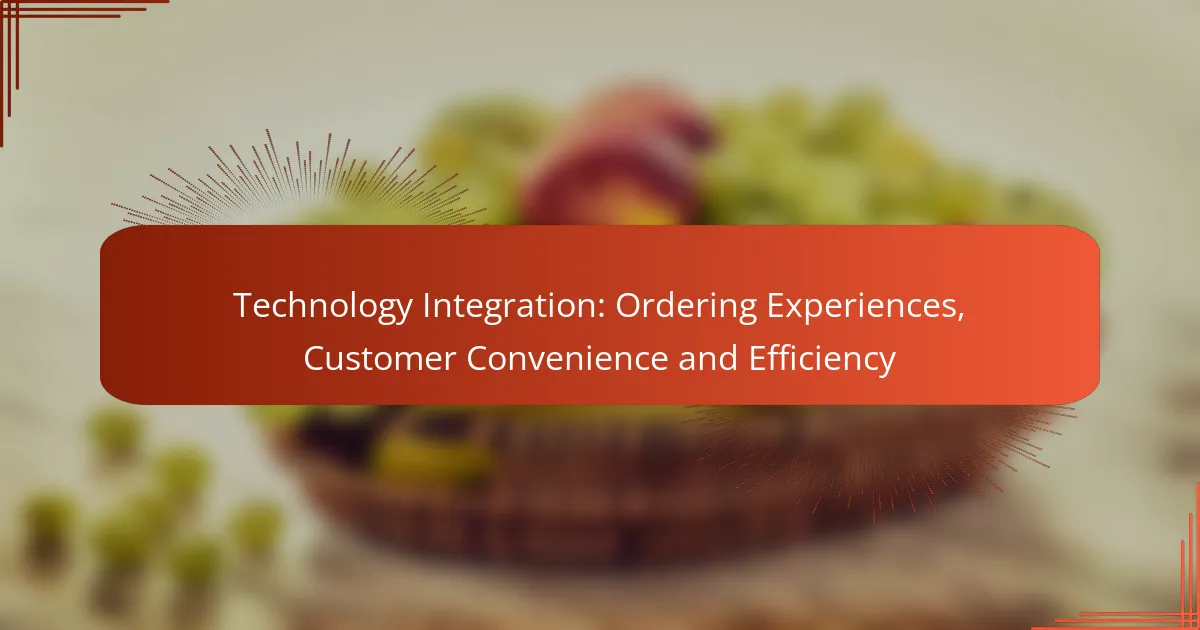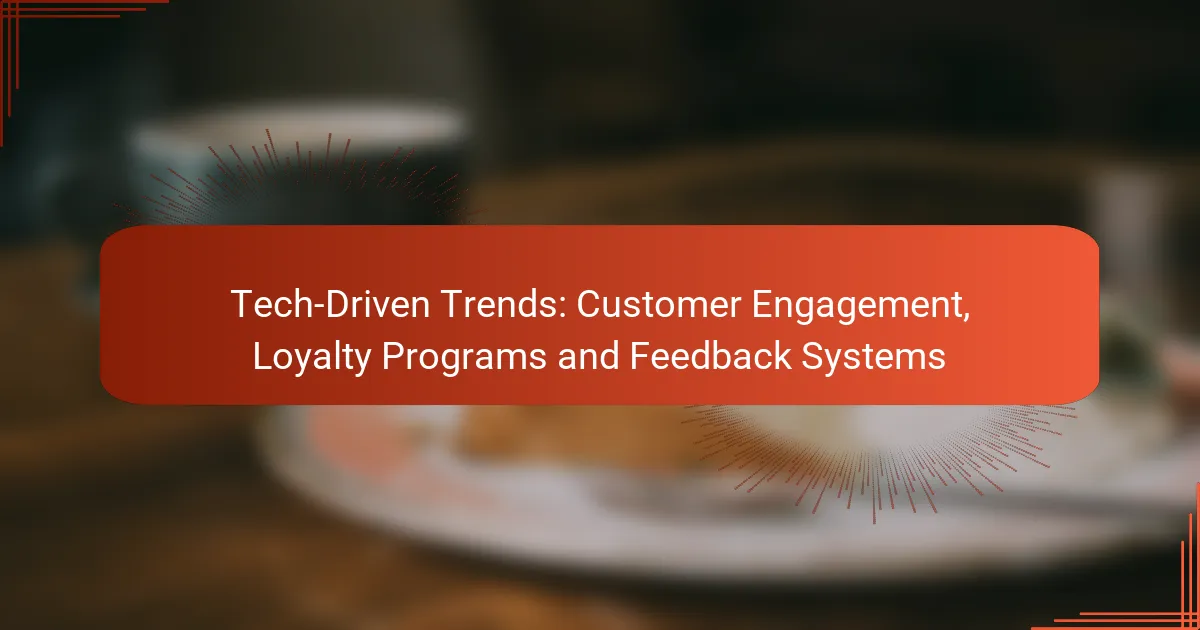In today’s digital landscape, technology integration plays a crucial role in transforming ordering experiences within e-commerce. By streamlining processes and enhancing user engagement, it significantly boosts customer convenience and operational efficiency. This seamless integration not only facilitates quicker transactions but also fosters greater customer satisfaction and loyalty.
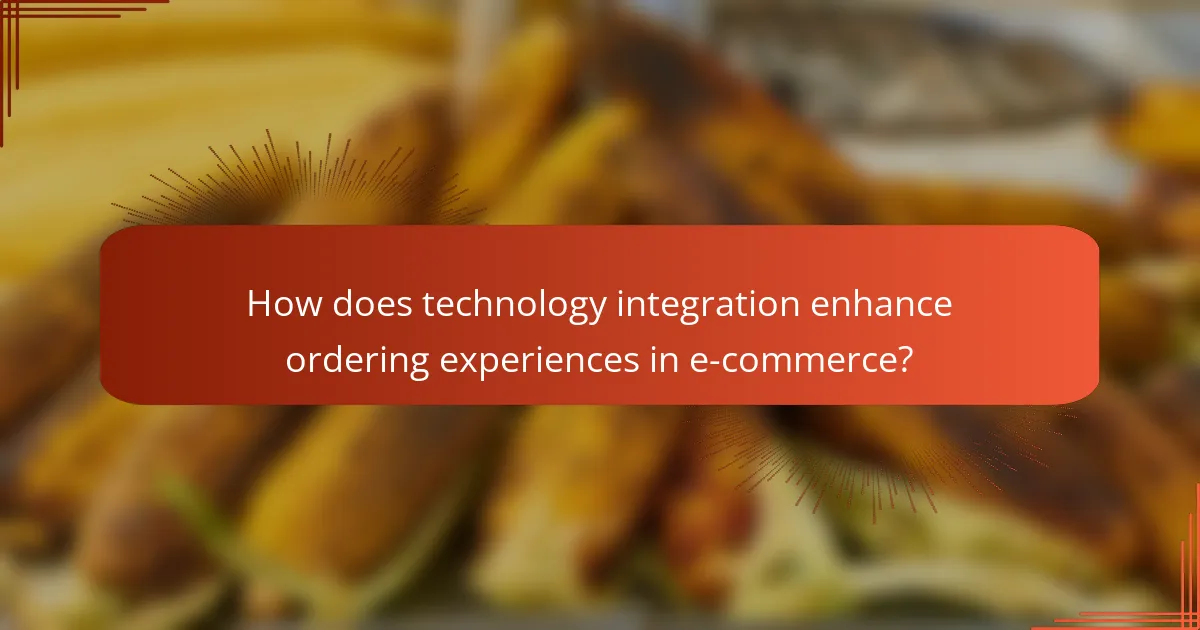
How does technology integration enhance ordering experiences in e-commerce?
Technology integration significantly improves ordering experiences in e-commerce by streamlining processes, enhancing user engagement, and providing real-time data. This leads to greater customer convenience and efficiency, ultimately boosting sales and customer satisfaction.
Improved user interface design
An intuitive user interface (UI) is crucial for a positive ordering experience. A well-designed UI simplifies navigation, making it easier for customers to find products and complete purchases. Key elements include clear categories, responsive layouts, and visually appealing graphics that guide users seamlessly through the ordering process.
Consider implementing features like sticky navigation bars and search filters to enhance usability. Regularly testing the UI with real users can help identify pain points and areas for improvement.
Personalized shopping experiences
Personalization in e-commerce tailors the shopping experience to individual preferences, increasing engagement and conversion rates. By utilizing customer data, businesses can recommend products based on past purchases, browsing history, and demographic information.
For effective personalization, consider using algorithms that analyze user behavior and preferences. Simple tactics like personalized email campaigns and targeted promotions can significantly enhance customer loyalty and satisfaction.
Real-time inventory management
Real-time inventory management ensures that customers have accurate information about product availability, reducing frustration and abandoned carts. This technology allows businesses to track stock levels and automatically update product listings across platforms.
Implementing a robust inventory management system can help prevent stockouts and overstock situations. Consider using cloud-based solutions that provide real-time data access and integration with e-commerce platforms for optimal efficiency.
Streamlined checkout processes
A streamlined checkout process minimizes friction and encourages customers to complete their purchases. Key features include guest checkout options, auto-fill for returning customers, and multiple payment methods to cater to diverse preferences.
To enhance the checkout experience, reduce the number of steps required to complete a purchase. Offering a variety of payment options, including digital wallets and buy-now-pay-later services, can also improve conversion rates.
Mobile optimization
With a growing number of consumers shopping via mobile devices, optimizing e-commerce sites for mobile use is essential. A mobile-optimized site provides a seamless experience, ensuring that users can easily browse and order products from their smartphones or tablets.
Focus on responsive design, fast loading times, and simplified navigation for mobile users. Regularly testing the mobile experience and gathering user feedback can help identify areas for improvement and enhance overall customer satisfaction.

What are the benefits of customer convenience through technology integration?
Customer convenience through technology integration streamlines the ordering experience, making it more accessible and efficient. This integration enhances user satisfaction by providing seamless interactions across various platforms and devices.
24/7 accessibility
Technology integration allows customers to access services and place orders at any time, day or night. This constant availability caters to diverse schedules, enabling users to shop or order whenever it suits them, which is particularly beneficial for those with busy lifestyles.
For example, e-commerce platforms and food delivery apps enable users to browse products or menus and complete transactions outside of traditional business hours. This flexibility can significantly increase sales opportunities and customer engagement.
Faster order fulfillment
With integrated technology, order processing becomes quicker and more efficient. Automated systems can handle inventory management, payment processing, and order tracking, reducing the time from order placement to delivery.
Many businesses leverage technologies like real-time inventory updates and automated logistics to ensure that orders are fulfilled within minutes rather than hours. This speed not only satisfies customers but also enhances operational efficiency.
Enhanced customer support
Technology integration facilitates improved customer support through various channels such as chatbots, live chat, and AI-driven assistance. These tools provide immediate responses to customer inquiries, enhancing the overall service experience.
For instance, a customer can receive instant answers to common questions via a chatbot, reducing wait times and improving satisfaction. This level of support is crucial for maintaining a competitive edge in today’s market.
Flexible payment options
Integrating technology allows businesses to offer a variety of payment methods, catering to customer preferences. Options may include credit cards, digital wallets, and even cryptocurrencies, making transactions more convenient.
Offering multiple payment methods can increase conversion rates as customers are more likely to complete a purchase when their preferred payment option is available. Businesses should regularly assess and update their payment systems to align with evolving consumer trends.
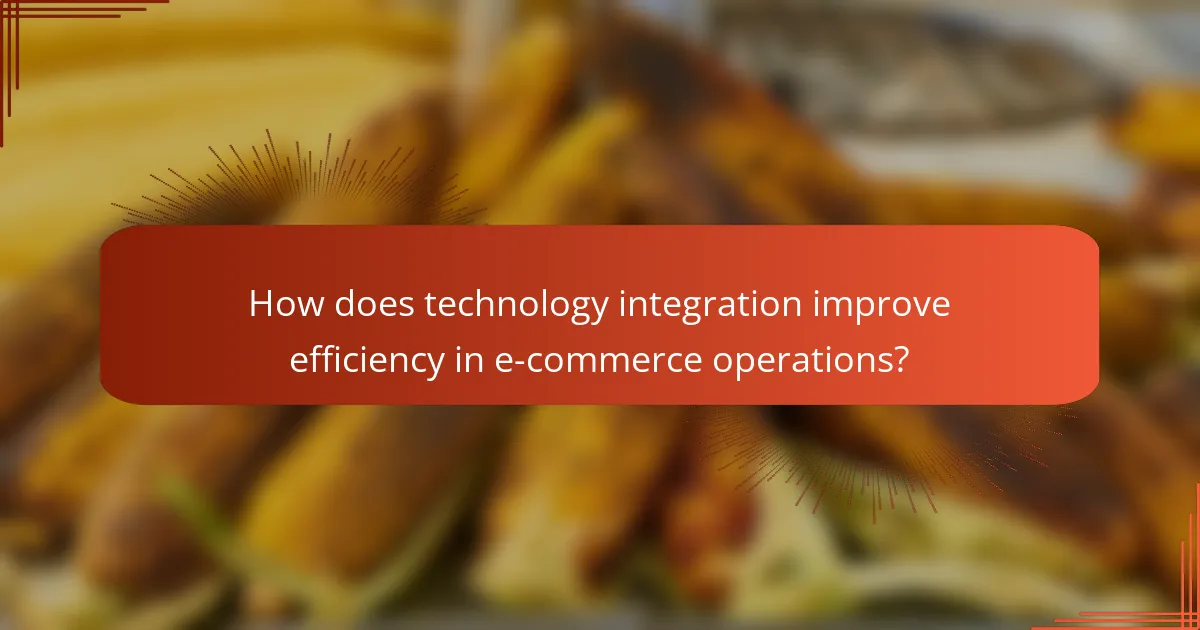
How does technology integration improve efficiency in e-commerce operations?
Technology integration enhances efficiency in e-commerce by streamlining processes, reducing manual tasks, and enabling faster decision-making. This leads to improved order fulfillment, better inventory management, and ultimately, a more satisfying customer experience.
Automated order processing
Automated order processing allows e-commerce businesses to handle orders without manual intervention, significantly speeding up the fulfillment cycle. Systems can automatically confirm orders, process payments, and generate shipping labels, reducing the time from purchase to delivery.
Implementing automation tools can decrease human error and ensure that orders are processed consistently. Businesses should consider integrating solutions like order management systems (OMS) that sync with their e-commerce platforms for seamless operations.
Data analytics for decision making
Data analytics empowers e-commerce companies to make informed decisions by analyzing customer behavior, sales trends, and inventory levels. By leveraging analytics tools, businesses can identify which products are performing well and adjust their strategies accordingly.
Utilizing data-driven insights can lead to better marketing campaigns and inventory management. Companies should regularly review their analytics to adapt to changing consumer preferences and optimize their offerings.
Supply chain optimization
Optimizing the supply chain is crucial for enhancing efficiency in e-commerce. By integrating technology, businesses can track inventory in real-time, forecast demand, and streamline logistics, which minimizes delays and reduces stockouts.
Tech solutions like inventory management software and warehouse automation can significantly improve supply chain responsiveness. Companies should evaluate their supply chain processes and invest in technologies that provide visibility and control over their operations.
Reduced operational costs
Integrating technology in e-commerce can lead to reduced operational costs by automating repetitive tasks and improving resource allocation. This can result in lower labor costs and decreased overhead expenses.
Businesses should assess their current operations to identify areas where technology can cut costs. For instance, using cloud-based solutions can reduce the need for physical infrastructure, allowing companies to allocate funds more efficiently.
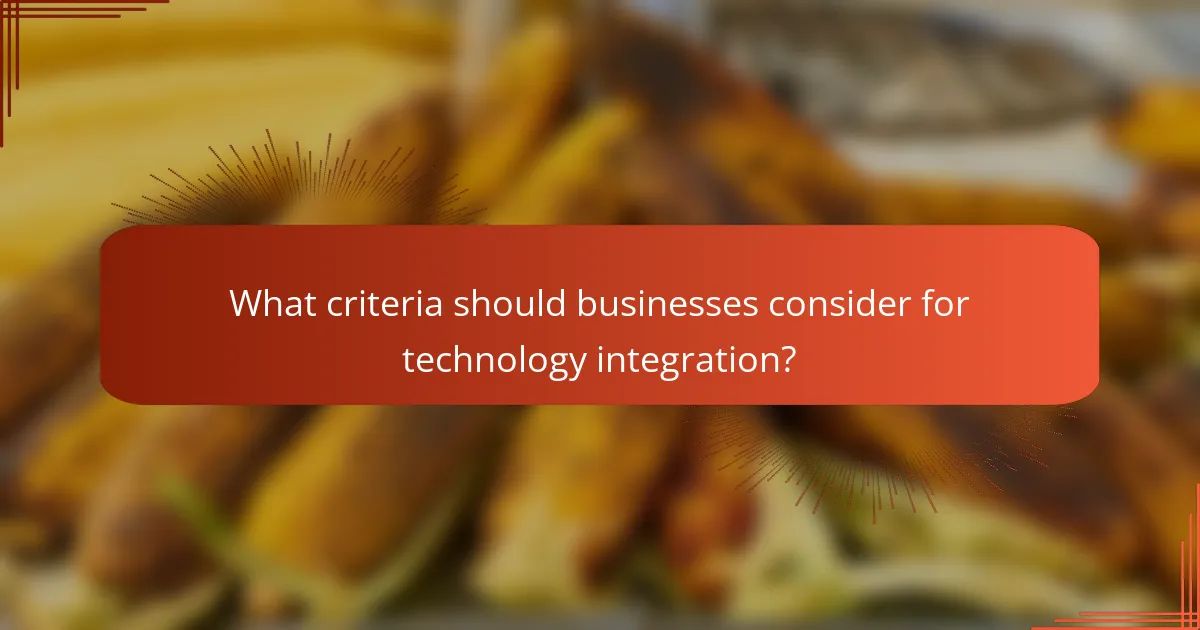
What criteria should businesses consider for technology integration?
Businesses should evaluate compatibility, scalability, and user training when integrating technology. These criteria ensure that new systems enhance operations, support growth, and are user-friendly.
Compatibility with existing systems
Ensuring compatibility with existing systems is crucial for seamless technology integration. Businesses should assess whether new software or hardware can work alongside current tools without requiring extensive modifications.
For example, if a company uses a specific customer relationship management (CRM) system, the new technology should integrate smoothly with it. Conducting compatibility tests before full implementation can save time and resources.
Scalability for future growth
Scalability is essential for accommodating future business growth. When selecting technology, consider whether it can handle increased demand or additional features as the company expands.
For instance, cloud-based solutions often provide scalable options, allowing businesses to pay for only what they use and upgrade as needed. This flexibility can help avoid costly overhauls later on.
User training and support
User training and support are vital for successful technology integration. Businesses should plan for comprehensive training sessions to ensure employees are comfortable using new systems.
Additionally, ongoing support is important. Establishing a helpdesk or providing access to online resources can assist users in troubleshooting issues quickly, minimizing downtime and enhancing productivity.
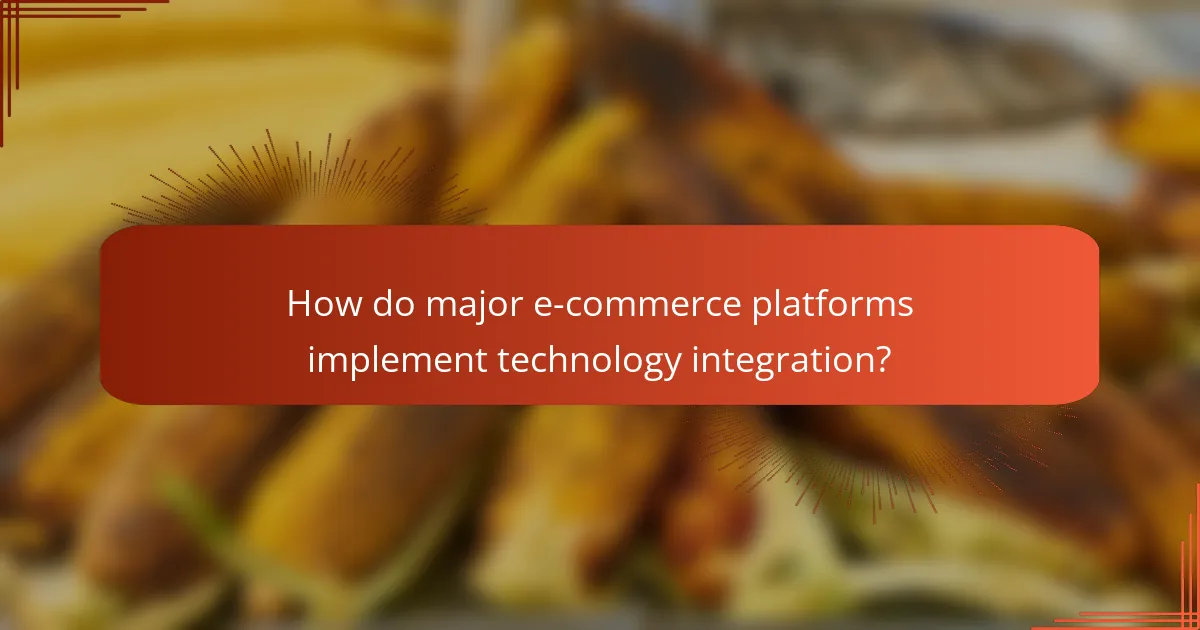
How do major e-commerce platforms implement technology integration?
Major e-commerce platforms utilize technology integration to enhance user experiences, streamline ordering processes, and improve overall customer convenience. This involves incorporating various software and tools that work together seamlessly, allowing for efficient transactions and personalized shopping experiences.
Shopify’s app ecosystem
Shopify’s app ecosystem consists of thousands of applications that merchants can integrate into their online stores. These apps cover various functionalities, including inventory management, customer support, and marketing automation, enabling businesses to tailor their operations to specific needs.
Merchants can easily install apps from the Shopify App Store, often with minimal technical knowledge. This flexibility allows for rapid adjustments to changing market demands and customer preferences, enhancing the overall shopping experience.
Amazon’s AI-driven recommendations
Amazon employs advanced AI algorithms to analyze customer behavior and preferences, providing personalized product recommendations. This technology integration enhances the shopping experience by suggesting items that align with users’ interests, often leading to increased sales.
By leveraging vast amounts of data, Amazon’s recommendation system can predict what products customers are likely to purchase next. This not only improves customer satisfaction but also boosts efficiency by streamlining the ordering process, making it easier for customers to find what they need quickly.
